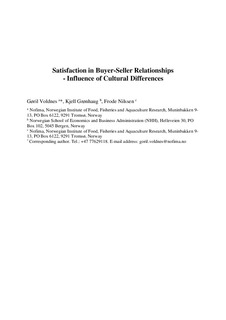| dc.contributor.author | Voldnes, Gøril | |
| dc.contributor.author | Grønhaug, Kjell | |
| dc.contributor.author | Nilssen, Frode | |
| dc.date.accessioned | 2015-03-12T08:29:23Z | |
| dc.date.accessioned | 2015-03-16T08:26:36Z | |
| dc.date.available | 2015-03-12T08:29:23Z | |
| dc.date.available | 2015-03-16T08:26:36Z | |
| dc.date.issued | 2012 | |
| dc.identifier.citation | Industrial Marketing Management 2012, 41(7):1081-1093 | nb_NO |
| dc.identifier.issn | 0019-8501 | |
| dc.identifier.uri | http://hdl.handle.net/11250/279250 | |
| dc.description | NOTICE: this is the author’s version of a work that was accepted for publication in
Industrial Marketing Management. Changes resulting from the publishing process, such as peer review,
editing, corrections, structural formatting, and other quality control mechanisms may
not be reflected in this document. Changes may have been made to this work since it was
submitted for publication. A definitive version was subsequently published in
Industrial Marketing Management 2012, 41(7):1081-1093 DOI: 10.1016/j.indmarman.2012.03.001 . Copyright © 2012 Published by Elsevier Inc. | nb_NO |
| dc.description.abstract | This paper addresses the possible influence of cultural differences on satisfaction in cross-national buyerseller relationships. Building and maintaining buyer–seller relationships have for long been acknowledged as beneficial for conducting international business (Dwyer et al., 1987). A prerequisite for the success of such business relationships is the satisfaction of the parties involved. However, in international business the involved parties are usually embedded in different cultures, which in turn may influence both expectations and behavior and thereby the satisfaction with business relationships. In spite of this knowledge, the potential impact of cultural differences on satisfaction in buyer–seller relationships has received little attention. Here we present a study on business relationships between Russian buyers and Norwegian sellers of seafood. A dyadic approach is used to cover both parties in the relationship, because they may perceive and emphasize aspects of their relationship differently. The findings reveal congruence between the partners in terms of antecedents important for achieving satisfaction. However, several differences are found regarding how to achieve various antecedents. There are also differences between how the Russian partners describe their own actions, and how the Norwegian partners perceive these actions. These differences are explained by cultural differences. Implications are highlighted. | nb_NO |
| dc.language.iso | eng | nb_NO |
| dc.publisher | Elsevier Ltd. | nb_NO |
| dc.subject | buyer–seller relationships | nb_NO |
| dc.subject | cross-national business | nb_NO |
| dc.subject | satisfaction | nb_NO |
| dc.subject | cultural differences | nb_NO |
| dc.title | Satisfaction in buyer-seller relationships - Influence of cultural differences | nb_NO |
| dc.type | Journal article | nb_NO |
| dc.type | Peer reviewed | nb_NO |
| dc.date.updated | 2015-03-12T08:29:23Z | |
| dc.source.pagenumber | 1081-1093 | nb_NO |
| dc.source.volume | 41 | nb_NO |
| dc.source.journal | Industrial Marketing Management | nb_NO |
| dc.source.issue | 7 | nb_NO |
| dc.identifier.doi | 10.1016/j.indmarman.2012.03.001 | |
| dc.identifier.cristin | 944687 | |
